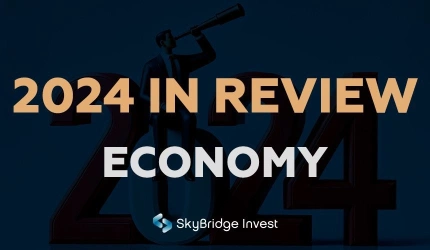As the year draws to a close, we begin a series of publications covering key developments in the global economy and financial markets.
This year witnessed significant shifts — from notable progress in the fight against inflation to unexpected geopolitical developments. The global economy in 2024 demonstrated a surprising degree of resilience and adaptability in the face of evolving conditions. Central banks in major economies successfully brought inflation under control, paving the way for a long-anticipated monetary easing cycle.
The disinflation trend in 2024 underscored the effectiveness of coordinated policy actions by monetary authorities. In the U.S., inflation declined to 2.7% by November, nearing the Federal Reserve's target level. The Eurozone also saw encouraging progress, with inflation falling to 2.2%, setting the stage for a more accommodative stance from the European Central Bank.
In emerging markets, the picture remained more mixed. In Kazakhstan, inflation slowed from 9.5% to 8.4%, while in China, it remained abnormally low, highlighting deeper structural issues in the economy.
Monetary policy underwent significant shifts during the year. The ECB began cutting rates in June, bringing the deposit rate down to 3% by year-end through a series of gradual reductions. The Federal Reserve followed suit in the autumn, lowering the federal funds rate in three steps to a range of 4.25–4.5%. In contrast, the National Bank of Kazakhstan tightened its policy stance in November, raising the base rate to 15.25% in response to persistent inflationary pressures.
Economic growth displayed marked regional divergence. The U.S. economy outperformed expectations with a full-year GDP growth rate of 2.4%, driven by resilient consumer demand and a strong labor market. The third quarter was particularly robust, with GDP expanding by 3.1% year-over-year.
China’s economy, despite significant stimulus measures, grew by just 4.5%, falling short of historical averages. Meanwhile, the European Union posted the weakest performance among major economies, with growth limited to 0.8%, reflecting the lingering effects of the energy crisis and ongoing geopolitical tensions.
The successful containment of inflation creates new opportunities for financial markets as the global monetary policy cycle turns. However, regional imbalances and heightened geopolitical risks suggest that 2025 will demand careful decision-making. Investors are advised to prioritize assets that benefit from strong U.S. consumption and to seek selective opportunities in emerging markets.


As the year draws to a close, we begin a series of publications covering key developments in the global economy and financial markets.
This year witnessed significant shifts — from notable progress in the fight against inflation to unexpected geopolitical developments. The global economy in 2024 demonstrated a surprising degree of resilience and adaptability in the face of evolving conditions. Central banks in major economies successfully brought inflation under control, paving the way for a long-anticipated monetary easing cycle.
The disinflation trend in 2024 underscored the effectiveness of coordinated policy actions by monetary authorities. In the U.S., inflation declined to 2.7% by November, nearing the Federal Reserve's target level. The Eurozone also saw encouraging progress, with inflation falling to 2.2%, setting the stage for a more accommodative stance from the European Central Bank.
In emerging markets, the picture remained more mixed. In Kazakhstan, inflation slowed from 9.5% to 8.4%, while in China, it remained abnormally low, highlighting deeper structural issues in the economy.
Monetary policy underwent significant shifts during the year. The ECB began cutting rates in June, bringing the deposit rate down to 3% by year-end through a series of gradual reductions. The Federal Reserve followed suit in the autumn, lowering the federal funds rate in three steps to a range of 4.25–4.5%. In contrast, the National Bank of Kazakhstan tightened its policy stance in November, raising the base rate to 15.25% in response to persistent inflationary pressures.
Economic growth displayed marked regional divergence. The U.S. economy outperformed expectations with a full-year GDP growth rate of 2.4%, driven by resilient consumer demand and a strong labor market. The third quarter was particularly robust, with GDP expanding by 3.1% year-over-year.
China’s economy, despite significant stimulus measures, grew by just 4.5%, falling short of historical averages. Meanwhile, the European Union posted the weakest performance among major economies, with growth limited to 0.8%, reflecting the lingering effects of the energy crisis and ongoing geopolitical tensions.
The successful containment of inflation creates new opportunities for financial markets as the global monetary policy cycle turns. However, regional imbalances and heightened geopolitical risks suggest that 2025 will demand careful decision-making. Investors are advised to prioritize assets that benefit from strong U.S. consumption and to seek selective opportunities in emerging markets.


